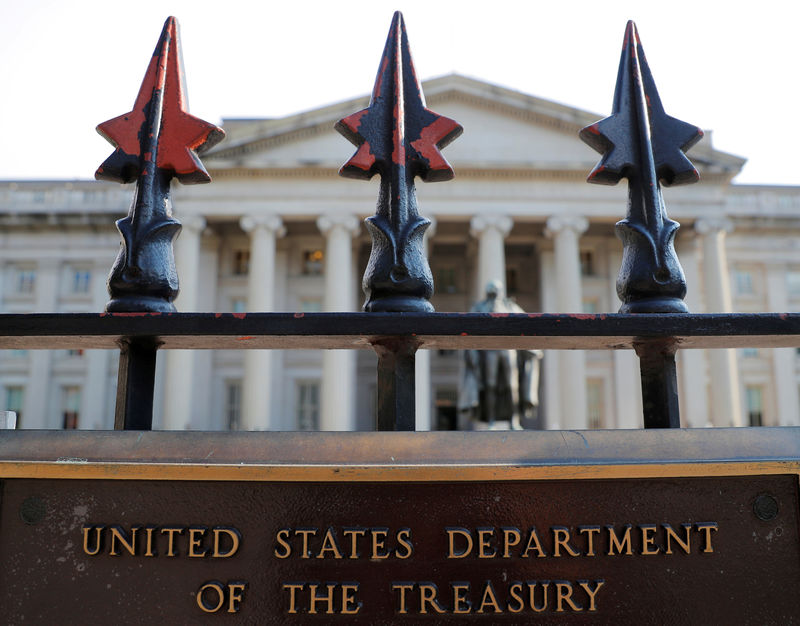(Bloomberg) -- Bond investors may get a chance next week to contemplate the soft spots in the U.S. economy rather than a geopolitical precipice. Either way, Treasury bulls have little to fear.
For now, haven buying of government debt has subsided as the U.S. and Iran appear to have backed away from escalating their conflict. The 10-year Treasury yield, the world’s borrowing benchmark, is around 1.82% -- the midpoint of its roughly 20-basis-point range this month. Yields sank on Friday, with the trigger coming from weaker-than-expected American jobs data.
The coming week features the signing of the so-called phase one of a U.S.-China trade deal and the expected beginning of President Donald Trump’s Senate impeachment trial. Both are unfinished business, but they may not have much market-moving potential. That puts the spotlight on economic news, even the best of which -- such as strong services-sector figures -- hasn’t done much to roil Treasuries lately. Next up: inflation data and an update on retail sales.
“The market has increasingly come around to the view that some of the forces that have pulled down rates in other developed markets have been at work in the U.S. as well,” said Steven Friedman, senior macroeconomist at MacKay Shields LLC. “So any backup in yields could certainly see buying interest.”
Concern over the growth outlook has dissipated since trade-war anxiety peaked in early September, but Treasuries still seem more sensitive to disappointing data than to positive surprises. Ten-year yields fell about 3 basis points Friday after the U.S. jobs report, and Friedman said lackluster wage growth was the driving force.
In his view, the next crop of price indexes poses little threat to yields at these levels, given that the Federal Reserve has signaled it will take a pretty profound swing in the inflation trend to shift to a more hawkish stance.
“It’s becoming increasingly clear just how patient the FOMC is going to be when it comes to inflation,” Friedman said. “They want to see a sustained and meaningful pickup in inflation before they would consider raising rates.”
Consumer prices are expected to have risen at a 2.4% annual clip in December. While that would be the fastest pace in more than a year, the Fed’s preferred gauge is still running well below its 2% target.
Friedman said market expectations for inflation over the longer term are likely to remain low until the Fed demonstrates it’s prepared to tolerate stronger pressures to make up for a decade of weakness. In his view, that could take another rate cut this year.
“Markets are really in a ‘show-me-the-money’ mood when it comes to inflation,” he said.
What to Watch
- Price dominate the economic schedule next week, which also brings the Jan. 15 signing at the White House of the phase-one trade agreement between the U.S. and China
- The New York Fed will release its new schedules on Jan. 14 for Treasury purchases and repo operations
- Here’s the economic calendar:
- Jan. 13: Monthly budget statement
- Jan. 14: NFIB small business optimism; consumer price index; real average earnings
- Jan. 15: MBA mortgage applications; producer price index; Empire manufacturing; Fed’s Beige Book
- Jan. 16: Import/export prices; retail sales; Philadelphia Fed business outlook; jobless claims; Bloomberg consumer comfort; business inventories; NAHB housing market index; Treasury international capital flow data
- Jan. 17: Building permits; housing starts; capacity utilization; industrial production; University of Michigan sentiment; JOLTS job openings
- It’s a full slate of speeches by regional Fed presidents:
- Jan. 13: Boston Fed’s Eric Rosengren on the economic outlook; Atlanta Fed’s Raphael Bostic discusses economic outlook and monetary policy
- Jan. 14: New York Fed’s John Williams (NYSE:WMB) discusses behavioral science at a London event; Kansas City Fed’s Esther George on economic, monetary-policy outlook
- Jan. 15: Philadelphia Fed’s Patrick Harker on monetary-policy normalization; Dallas Fed’s Robert Kaplan addresses Economic Club of New York
- Jan. 17: Harker on the economic outlook
- And the auction schedule:
- Jan. 13: $42 billion of 13-week bills; $36 billion of 26-week bills
- Jan. 16: 4-, 8-week bills
